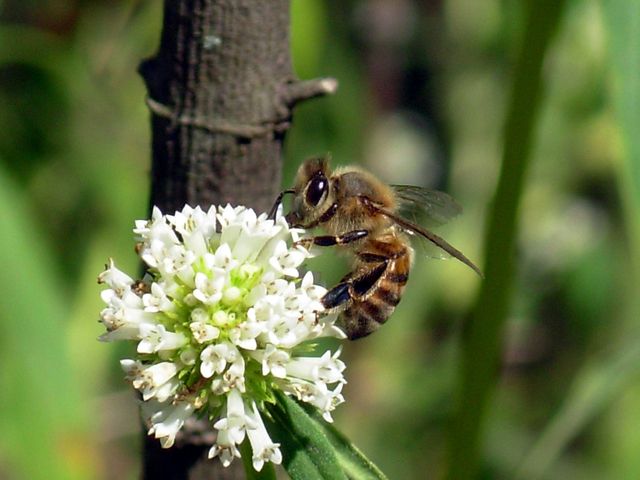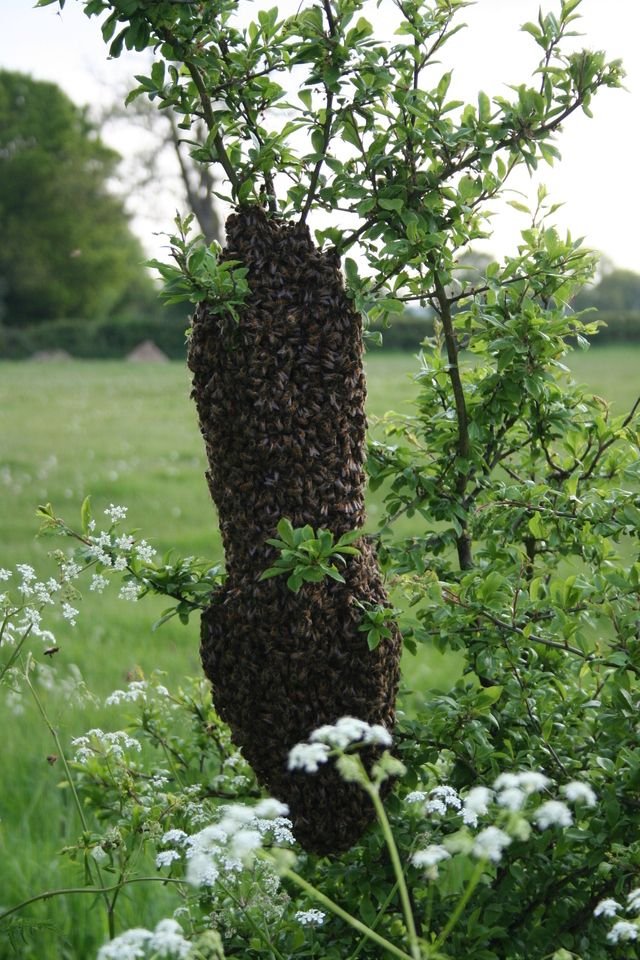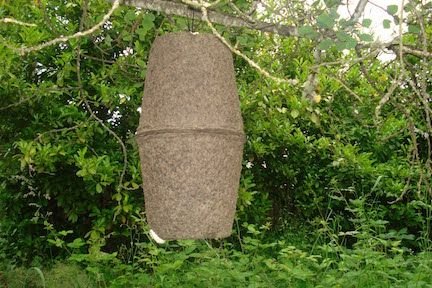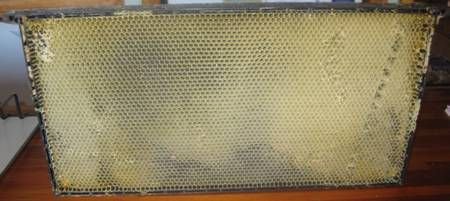How to Trap Feral Bees to Build Your Apiary
Here in the northern hemisphere, Central Louisiana to be precise, the days are getting longer and in a few weeks the clover will bloom and the pollinators will be out and busy.

A Honey Bee Gathers Nectar From a Blossom
Wild colonies of honey bees will soon transition from a tight cluster, whose main purpose is to protect the queen mother and to keep her warm during the bitter winter months, into busy foragers bringing stores of nectar and pollen back to the hive.
The queen increases egg laying to replenish the diminished number of workers and soon the colony will experience a population explosion.
Nature’s way of dealing with this sudden expansion is to cause the worker bees to begin forming queen cells to raise a new mother for the hive.
The old queen leaves the hive with roughly half the worker population (and half the honey stores as well) in search of a new home.
This can occur quite early in the spring so it is advisable for the beekeeper to be prepared with several swarm traps ready to catch these feral swarms.

A Feral Swarm Has Attached Itself Temporarily to a Branch
It is this behavior that a wise beekeeper will exploit to grow her apiary and an opportunity for the new hobbyists to begin his own.
Imagine that! FREE BEES!!!
Here in Central Louisiana, the winter temperatures are often warm enough for bees to be out searching for food. Anytime the temperature is 55 degrees Fahrenheit or above, bees will be flying.
If you set out shallow trays of sugar water you can determine if there are feral bees in the areas you have selected to place your traps.
I use 5 pounds of sugar to 5 cups of water for a 2:1 ratio to make a thin syrup to attract the local bees.
Bring this mixture to a boil, stirring constantly, then remove from heat and cool to room temperature.
If there is a nectar flow, bees will ignore your feeders, so be aware, if you are scouting for a place to set your traps, do it during a time when there is a dearth of available forage.
Activity at One of My Feeders. Outside Temperature = 63 Degrees Fahrenheit.
Oh, and to be "bee" friendly add some rocks or straw to your trays so the bees won't drown in the syrup.
Swarm traps can be purchased from a bee equipment supplier, like Mann Lake, but as a woodworker I prefer to build my own.
The commercial traps I've seen look like two five gallon nursery pots, inverted and screwed together. (see picture below)

Once assembled they are baited and hung in a likely area.

The problem I have with this style of trap is, once you catch a swarm, transferring the colony to the standard Langstroth hive is incredibly difficult.
If the swarm has been left in the trap long enough it will be more of a cut out than a transferral.
By far, the better method is to build your traps as standard five frame nucleus hives.
If you use this method, you can easily transfer your feral colony into a standard hive when they outgrow the trap/nuc.
I have built several of these nucleus hives from free plans you can find on the internet. My favorite site for free plans is http://beesource.com.
I use the "5 Frame Nuc - D. Coates Version" found here: http://beesource.com/build-it-yourself/5-frame-nuc-d-coates-version/ and modify it for my needs.
I had some exterior OSB left over from a recent project so I made mine from scraps.
I use a 1" X 2.5" X 24.5" piece attached to the back with screws and drill a 1" hole near the top of this piece to facilitate hanging the trap from a tree. (see picture below)

I also fix a small piece of 1/4 inch plywood to the front of the box to close over the entrance hole to keep the swarm inside while transporting.
Note the nail driven up from the bottom through the center of the entrance hole. This is to prevent the occasional wren from nesting in your box.

Open

Closed
Because I will leave the swarms I catch in the nucleus hive until they are well established, I also drill a 1" vent hole near the top and back of the box and cover with screen to keep out invaders.
Ventilation is essential for a healthy hive. Bees are very efficient at controlling their hive temperature, but without good ventilation the moisture buildup will cause them to abscond.

Vent Hole

Screen Cover From Inside
The best way to prepare your trap is to fill it with two or three frames of drawn comb near the center of the nuc box then fill the other spaces with frames prepared with empty foundation.

A Frame of Drawn Comb

Frame With Plastic Foundation
If you are a new beekeeper and don't have a source for frames with drawn comb, don't despair!
I learned a neat trick from an old beekeeper. He uses strips cut from wax foundation (the kind without supporting wire structure).
He attaches these to the groove in the top of the frame using hot wax applied with a turkey baster.

Note the Strip of Wax Foundation Glued to the Top of the Frame with Beeswax
"All the girls need, is something to build on," he said.
Bees are gorged with honey when they swarm and one of the first things they do is convert these sugars to wax and then to comb. They quickly build a structure for their queen to lay brood in.
I intend to try a few boxes loaded with frames prepared this way.
I'll let you know how successful I am.
Okay! So, now we have all of our traps built and we're ready to set them out.
Most of the literature suggest you set your traps just inside a wood line facing an open area such as a hayfield.
Your trap should be facing the south (northern hemisphere) and elevated at least six feet from the ground. (eye level works for me)
You will need three things to make your trap especially attractive to scout bees.
A small bottle of lemongrass oil, available as an essential oil on Amazon.com, some Q-tips, and lastly some plastic sealable sandwich bags.
I actually saw a small bottle of lemongrass oil at Walmart, in the craft section.

To bait your trap open the top and remove about four frames.
Wet the end of a Q-tip with the lemon grass oil.
Wipe just a small area (about an inch long the width of the cotton tip) on the top of one frame near the back of the box and smear some around the opening.
Place the same Q-tip inside the sandwich bag and close the opening about half way.
Place the sandwich bag in the bottom of your trap, replace the frames and secure the lid.
The trick here is to be extremely conservative with the lemongrass oil.
The literature stresses that too much lemongrass oil will actually repel any scout bees from selecting your trap for their new home.
Once your trap is set, hang it at your selected location and check it for activity at least once a week.
Avoid rebating for at least six weeks, the lure last a long time!
It is wise to write your contact information where it is clearly visible to the public. I write mine in sharpie across the front of the box along with a warning, "DO NOT DISTURB / STINGING INSECTS"!
Oh, and be sure you have the landowner's permission and let anyone in the immediate area know you have a trap out so they won't be surprised if they stumble onto it.
Once you have caught a swarm, leave it alone for a week or two so that it becomes well established in its new home.
When it's time to retrieve your new colony, approach the trap after sundown when you are sure all of the foragers have returned for the night.
Avoid shining light on the opening and gently close the entrance to the hive.
Transport your trap to its new home and place it in the same spot that you plan to place the full sized hive they will eventually occupy.
Open the entrance and run!
JUST KIDDING!
I hope this post is useful!
Please repost if you know others that may find it valuable!
Leave comments and......
CARRY ON!!
Just curious where the NewbieResteemDay image comes from and if you are using it correctly........
There is lots going on on Steemit... So probably just something I am not familiar with.... But it states your content has been upvoted and resteemed.... That seems like a comment more than a footer in your post.
You know, I failed to read the fine print, thanks for bringing that to my attention. I got it from this reply I got from them at the bottom of this post: https://steemit.com/newbieresteemday/@beekerst/a-slideshow-of-early-louisiana-forestry-practices .....I read it to mean "please use this in your post" I'll edit them out...I attached it to several post.....I'm so embarrassed I just realized a tag is what's at the bottom of the post and directs a post to a certain interest group and the image is certainly not the tag! LOL I'm such a newbie....please forgive me!
No worries. Steemit is a complex and confusing place!!! Big learning curve.
Peace
You read it right... You are welcome to use newbieresteemday always. We like your work and fully support you! Its awesome how well you're doing and we are very happy for you and your kind words. In fact, I posted today about your comment and the pat on the back you gave!!!
Hey healthy-home, I think he may have edited whatever you were talking about out of his post, but I wanted to tell you that we are a group that is trying to support the newbies in their first month to get going and feel welcomed. @beekerst is doing great and we spotted him right off the bat and we are so happy that he is doing well! I wanted to let you know that I love to see people trying to help others, so it is awesome that you tried to give him constructive advice! In this case though, we welcome anyone to use our feed as long as they are trying to do the right thing in general!
Have a great day and nice to meet you :)
Very informative post! The nucleus hives are very cool! I had a bad experience with bees when a hive was found inside the walls of a home I lived in when young. Imagine swarms of bees attacking 10 yr old kids. Lol. Will stay away from Bee hives but your post is helpful to others.
LOL, I too had a bad experience with bees once.....but they were bumble bees and very aggressive! Most of the old beekeepers I know don't even know where to find their "sissy suits" and work their hives without any protection!
There's a guy on YouTube "The 628 Dirt Rooster". He is a hoot to watch! He must get stung 20 times or more in some of his videos! It doesn't seem to bother him at all.
Ouch. May have to watch that YouTube video. Sounds like a dangerous hobby/profession.
I’m part of the #newbieresteemday initiative. We’re a group of volunteers trying to help newbies have a good start after spending time writing a good post. Use our hashtag next time for your posts and we can help get it more exposure. 🙂
Hey, thanks! I'll do that. I'm all about getting more exposure!
You can check out our partner’s page. She does a lot of homesteading posts. @goldendawne
Best to you on here!
thank you @beeyou!!
And @beekerst Welcome to steemit! If you are ever looking for a group, actually a community, of homesteaders/gardeners/self-sufficient like-minded people, I am the moderator of a group here... also the "un"official ambassador to the group.
let me know and I can post an invite link here for you!
Thank you @goldendawne! I'd like that very much! I'm an avid gardener and vintner and have a lot to share about my vineyard, orchard and garden! I'd love to have that link!
Welcome to SteemIt! I see my friends with the Newbie ReSteem Initiative have already found you, that's great!
I have to say I have never considered being a beekeeper, but honestly this post kept me interested the entire way through. I also come away feeling that if I wanted to I could go out and setup a trap and wait for some stray bees to come along.
I definitely look forward to reading more of your stories. Great to have you here.
Thanks for the encouragement! I'm glad you enjoyed my post! Very nice to meet you!
Congratulations you have been upvoted and resteemed as part of #newbieresteemday's top 10 posts for the day! ... We invite you to use our tag to connect with more of our members. To learn more: Come Join Us!!! (Newbie Resteem Initiative)
Wow! I made the top ten???? I'll be sure to use the tag every time I post!
Great! We wish you the best on here. Look forward to more great posts!